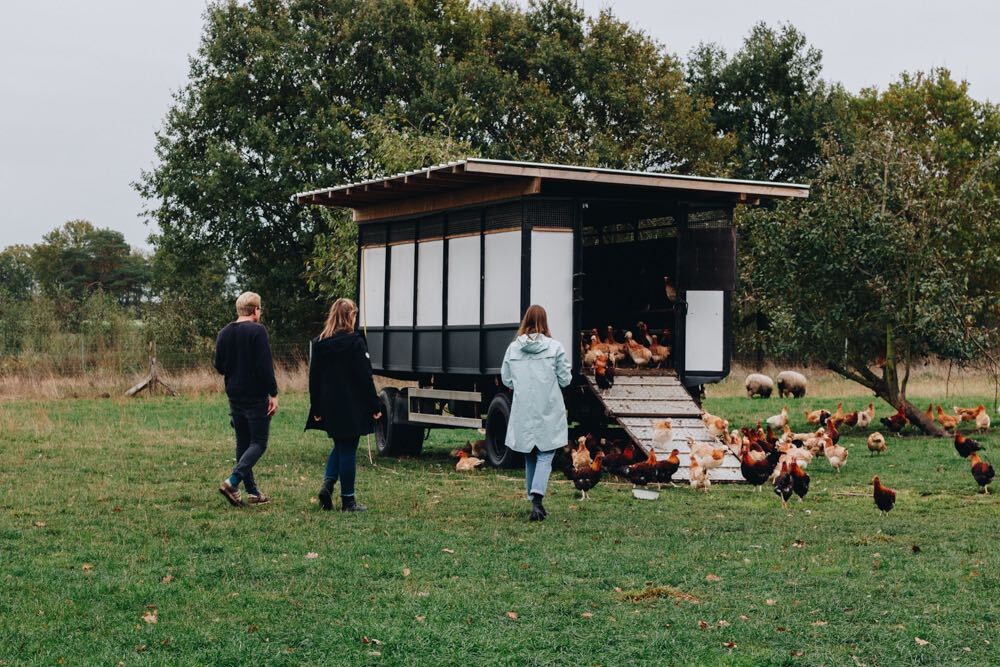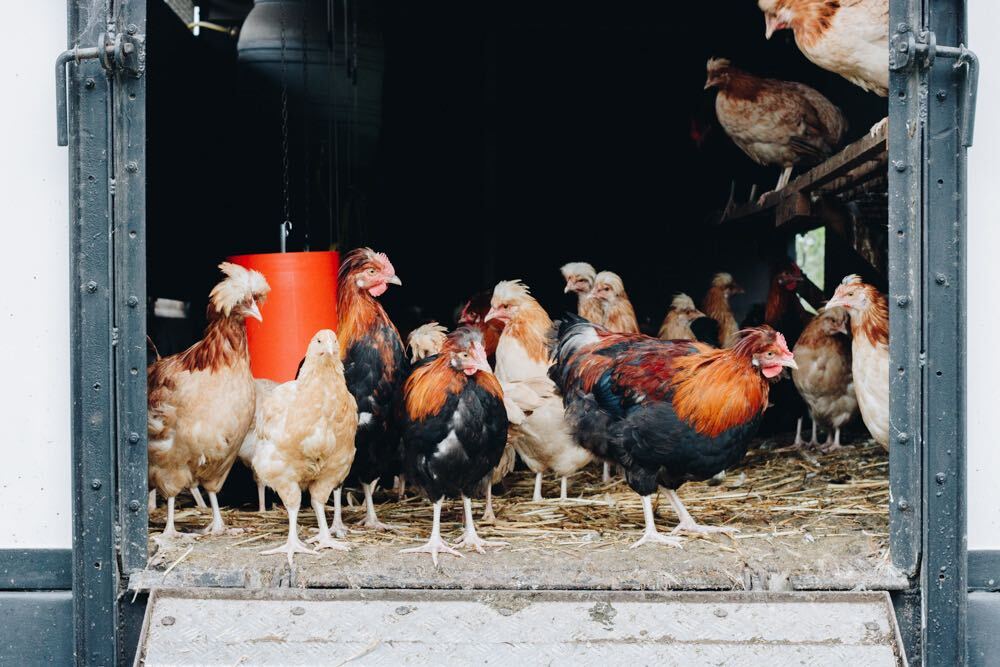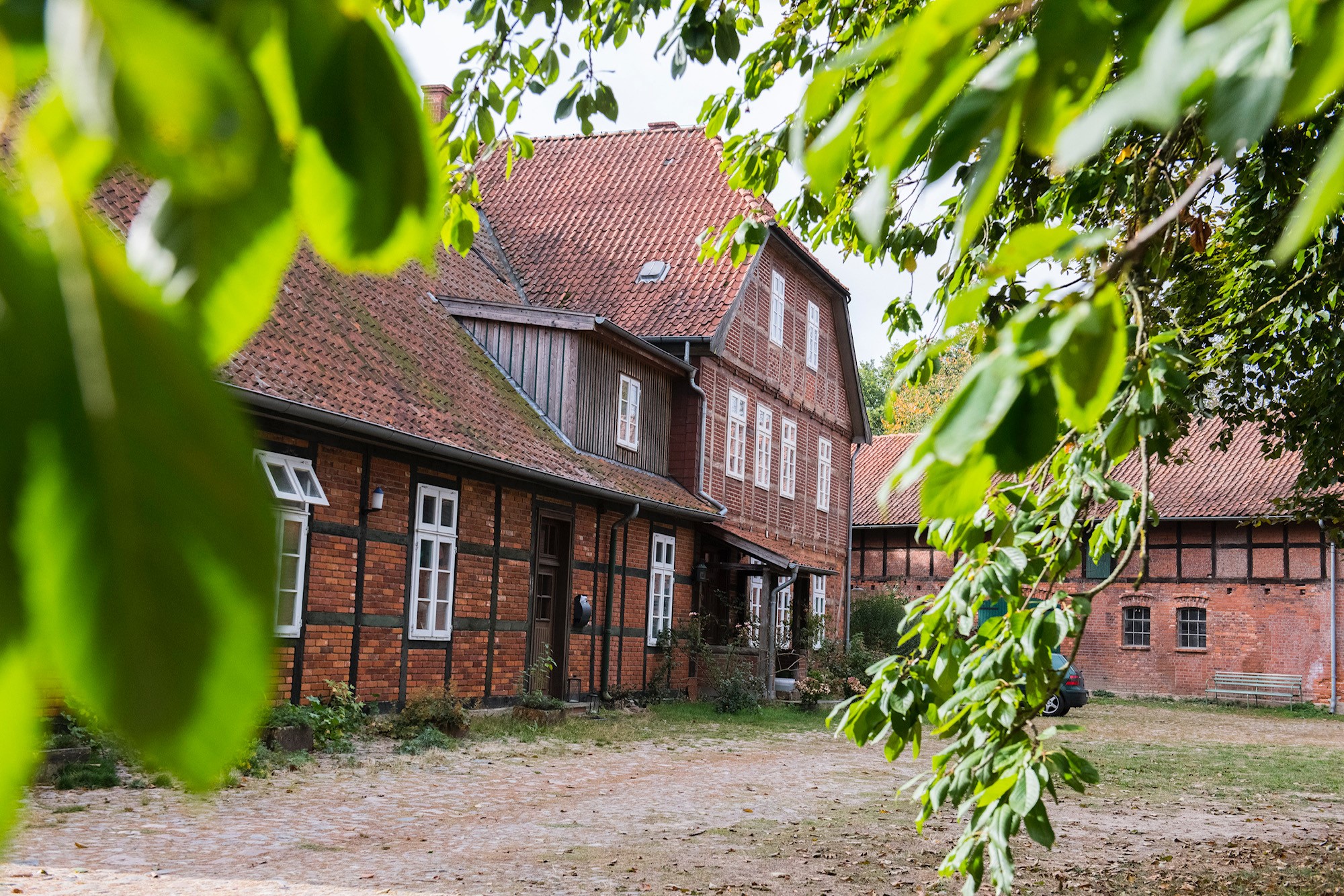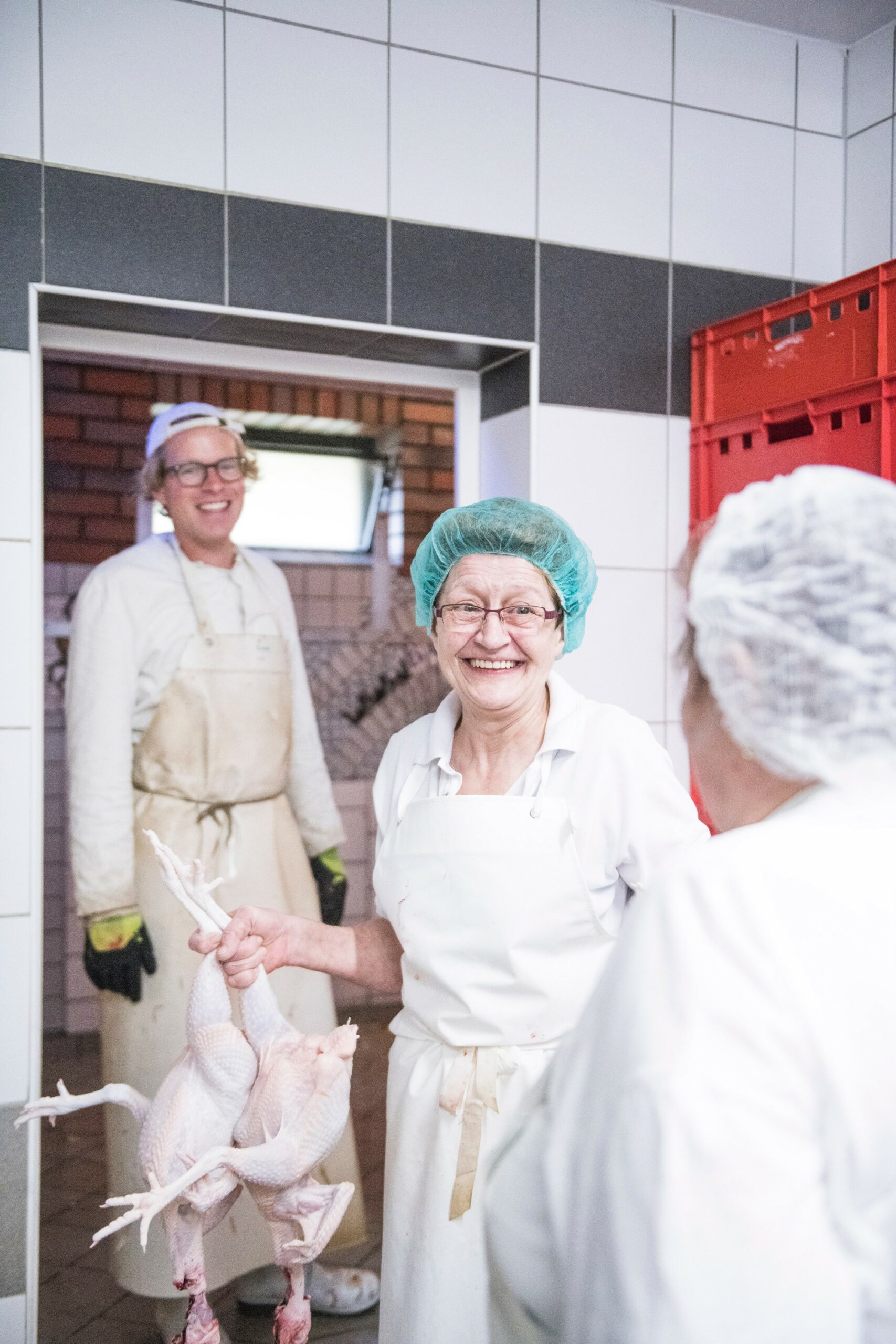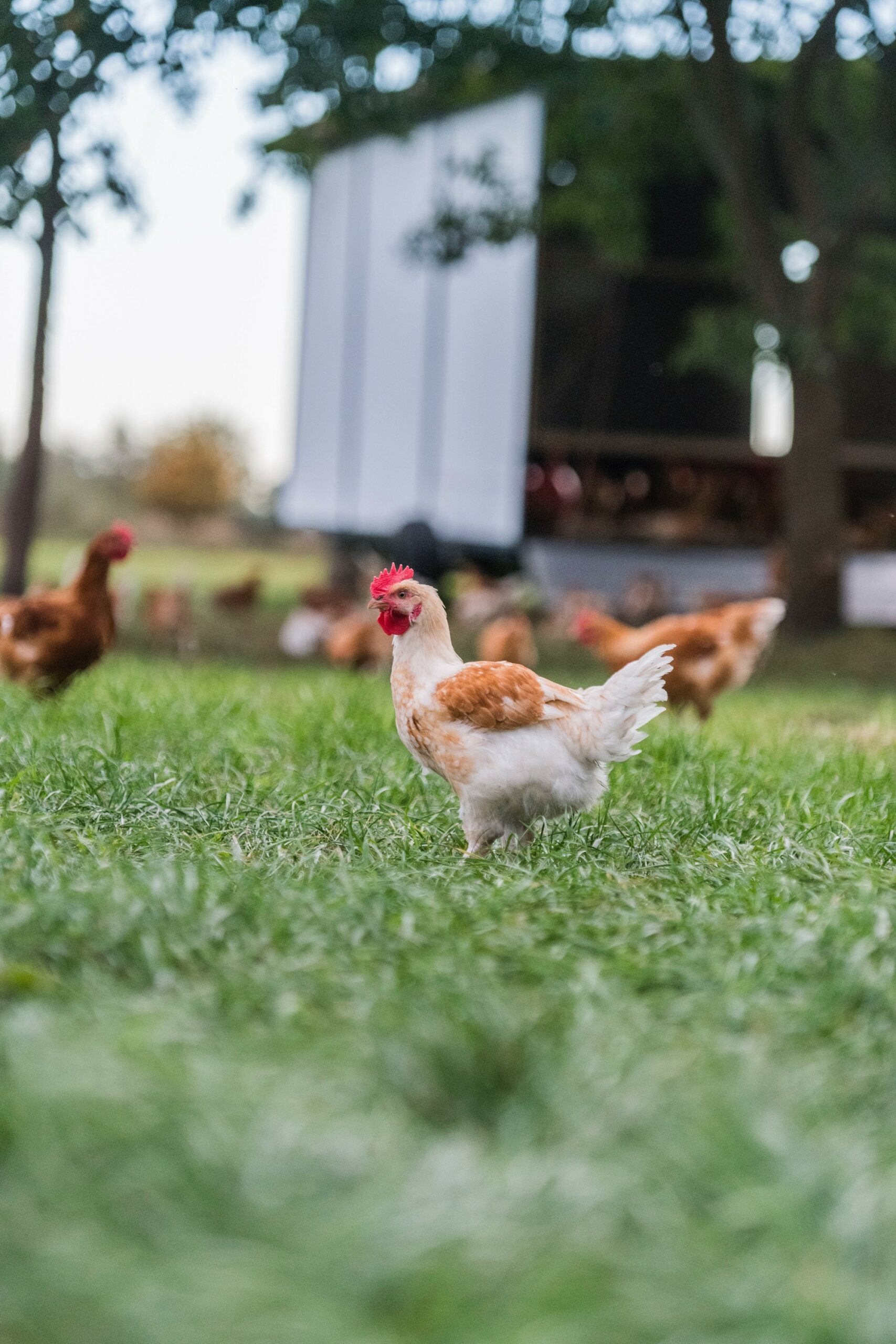Odefey & Töchter
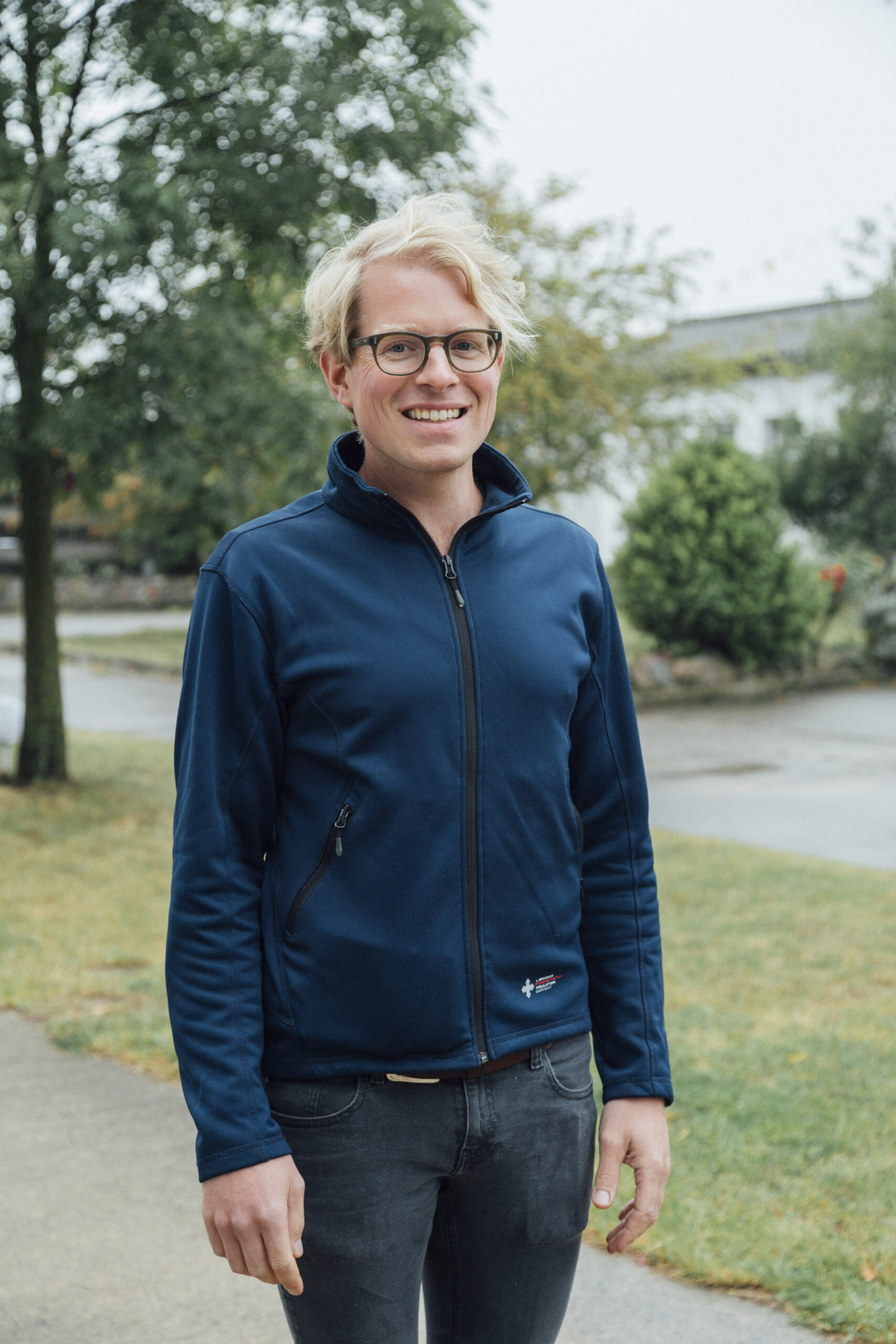
With his poultry farm Odefey & Töchter, Lars Odefey has become one of the most pioneering poultry breeders in Germany since its founding in 2017. He markets his free-range chickens directly to cooks and private consumers. From hatching, rearing, free-range husbandry to slaughter, the animals spend their entire lives on his own farm in the Lüneburg Heide. We talk to him about sustainable meat production, cooperation with gastronomy and the development of his farm.
Hello Lars, why don’t you start by introducing yourself and telling us about Odefey & Töchter.
I’m Lars, 38, a farmer and have been self-employed for four years now. In 2017 I decided to leave my previous job and take over the farm of my parents to start breeding, raising and slaughtering poultry – currently mainly chickens. At the moment I have around 3000 chickens, a few sheep and my dog Lotti.
What makes Odefey & Töchter different from other poultry farms?
My father used to keep chickens and we came together and asked ourselves: what does a chicken actually need to have a good life? A chicken needs space, it needs a perch to sit on, it needs a dry coop but also a meadow, lots of space with green grass and then also some shade and space for sand bathing. Good food definitely plays a role. Especially important is above all: time. As with all things from which good food is to be produced, it needs enough time. Our “fastest” chicken takes three and a half months, and the slowest, which are special breeds, take half a year. That’s about six times longer than a standard chicken from the supermarket.
Can you say more about what makes the difference to conventional chicken? Why are your chickens comparatively expensive?
It starts with the genetics. You can derive everything else from that. Then the structure of the coop, duration of rearing, as well as the feed are all deciding factors. We actually do everything differently than the industrial productions. For example, we have groups of animals. So a maximum of animals per barn in mobile or fixed barns. This means that the animals have less stress because they can actually recognize each other within a certain group size. And in the industrial productions, there are usually 40,000 animals per barn. So huge units. Furthermore, we feed by hand instead of in automatic feeders. We take a wheelbarrow or a bucket and carry the feed to the stations and pour it into the troughs by hand. The same goes for the watering troughs and for cleaning up. We hardly use any mechanization or automation. That means you actually see the animals. I’m with them at least three times a day. In the morning to feed them, let them out, fill up their water, and move the stalls. In the afternoon, feeding again. In the evening I am closing the flaps overnight when all the chickens are inside. I have a relatively close relationship with the animals because of this, which I think is cool, because when you have 40,000 animals in a barn, no human can keep track of them. These are halls like soccer fields, from which the animals never get out. So the industrial process is actually completely anonymized, so to speak.
How did you come to take over your parents’ farm as a young person and do everything “differently”? It is a big life decision that you made.
I was seven when we moved to Uelzen from Schleswig-Holstein. I have four siblings and we had a big house, lots of space and I thought it was cool as a little boy and I did quite a lot with my father back then: stuff like building huts outside. My father is also a hunter like me. We did that together and then on Sunday we had venison saddle, which my mother cooked. So the topic of meat and then agriculture and forestry was always a subject. Then I was away for 10 years, because Uelzen is a tiny village. At the age of 18, 19, 20, you think to yourself, “Okay, I have to leave here”. At that time, I didn’t have plans to come back here. Then I studied organic agriculture in Eberswalde and Hohenheim and spent some time in Berlin and Hamburg. At some point my parents retired and said, “We really want to sell it now,” and they already had brokers there. That was when I started seriously thinking about whether I should start something here. At first, I thought exclusively about a residential project with communal living. Then I moved back here in 2014, in 2015 I took over the land and in 2017, so relatively quickly afterwards, I picked up farming again and quit my old job. As I said, there was already a bit of infrastructure here: the building, the cooling storage, and tiled rooms for slaughtering.
Was that the plan from the beginning, that the slaughterhouse should also be on site?
For me definitely because of the history of this place. My father had geese, turkeys and broiler chickens back then. At that time, they still came from Austria. We picked up the chickens in Styria. Then, of course, the classic thing is that as soon as they’re fat enough, you take them to a professional slaughterhouse. There is not only Wiesenhof and Tönnies, but also a few medium-sized companies. For that, we had to drive two hours to the nearest slaughterhouse, at that time it was Nienburg on the Weser. At that point, when I was 15 or 16, I couldn’t really get my head around it. Death is always something surreal. I didn’t want to load up the animals for slaughtering on my farm. As a rule, that happens in the evening. Then they stand around on the farm until you start the journey at four in the morning. On the way you have the street noises, then they are slaughtered by some people who don’t know the animals and the animals don’t know them. Anonymously. Afterwards you get something back. You get your animal back, but you don’t know what the hygiene procedure is. You don’t know how the cuts are, you don’t know how they are gutted. The last step is essential for the meat quality. We only slaughter our own animals here. We don’t slaughter for anyone externally and we don’t buy animals to slaughter and resell them. We raise all the animals ourselves, slaughter and market only our own.
On the topic of marketing: How do you work together with other businesses such as the gastronomy and other farms?
There are multiple topics here: It started with a lot of door-to-door sales work – writing to restaurateurs out of the blue, then going there and introducing yourself. My father already had a few customers in Hamburg. But times have changed. The whole issue of regional production, especially in the poultry industry, has become more important. The top chefs and cooks no longer just buy solely in France as they did in the 70s and 80s. Good products are also coming from Germany and its various regions. This has changed! This close network, due to the climate and sustainability discussion, has picked up speed in the last 5 to 10 years. Regionalwert AG or Die Gemeinschaft have emerged from this. For me, this close exchange means that you get relatively quick and direct feedback: How was the buyer’s experience? How did the animal taste, how did the customers like it? Many friendships have developed from these partnerships. For me, working with others is mainly about knowledge, but also about fun and enjoyment. Food and drinks.
Quite a bit has changed since your launch in 2017: You now have your own hatchery and you experiment a lot with different breeds. How did that come about?
In the beginning you don’t have a good overview of what’s available and what you can do, and what the customers want. Then you just do something and see if it works. And you have an initial plan that you think will work. But it is usually the case that the business plans are hardly congruent with reality. Breeding was the decisive point for us, where we wanted to change something. We started with a normal hybrid crossing of chickens for meat production from the Bio – sector, because it was the most obvious thing to do. We followed Bio criteria in terms of space, pasture, nitrogen and phosphorus inputs. That was also okay at that time. We were a small-scale manufacturer with on-farm slaughtering. But we didn’t really have the success we wanted with that, because it was just too comparable to a Bio chicken, which you can just get at the Bio supermarket instead. At the same time, we couldn’t sell it as cheaply as a big Bio farm in 3- 4- 5,000 units with a huge slaughterhouse behind it. Because we are just too small. So it became clear that we had to do something that no one else was doing or that didn’t exist yet. We were looking for the “positive uniqueness”! This has remained so until today. Hence the hatchery and the different breeds. This year we want to try pheasants together with the Horvath in Berlin. And turkey! Because turkey, much like chicken, has a terrible image in Germany. It has such a bad reputation that people don’t even want to eat turkey anymore. But actually turkey is also a totally good product.
I have the feeling that only the breast is ever available from turkey.
Yes, it is also bred that way. The breast makes up a third of the total weight. Huge breasts that weigh 1.2 kilos, so that in the end they can’t even walk. And the constellation is almost even more dire than with a chicken – I think one company supplies over 90 percent of turkey genetics worldwide. In the case of chickens, there are still three. One from the USA, one from the Netherlands and one from Germany.
That’s exactly why we looked further. Also with people like Thomas Imbusch and Micha Schäfer, who of course received or tested the products we produced. And then it gradually happened that we started…
What exactly does such a process of further development look like? For example, you work closely with restaurateurs, including members of Die Gemeinschaft. What does such a partnership and the path from the idea to the plate look like?
I already knew Micha Schäfer, head chef at Nobelhart und Schmutzig. Looking back, this partnership has grown into a friendship over the years. It starts with writing a blunt email and hoping something comes back. By now, I virtually know the daily rhythm of chefs. It fits quite well with mine: Don’t get up before ten. When they start, so between 10 and 2 p.m.: drinking coffee, doing the preparation, chopping things, pre-cooking things, then I call the kitchens and say: “Good morning, here I am.” Maybe you get lucky and they have a little bit of time at that point. I’ve also always tried to go there. The personal conversation, even if it’s just about the chicken you’re dropping off, is always worth a lot. Then after a few days you receive the feedback: the chicken was good/was bad. The breast was like this; the drumstick was like this. What can you do? What else can you deliver? How is the price? With Thomas Imbusch (100/200 kitchen) and Micha Schäfer (Nobelhart & Schmutzig) they are now not only customers, but also a kind of “research team”. Like a partnered food lab for me. The great thing about it is that when I tell both of them today: “I have something new, we now have a blue chicken, the blue miracle from Mehre” or “we now have Sulmthaler”, then Thomas Imbusch always immediately says “Yeah cool, I’ll take it, send Five – Ten – Hundred”. He trusts me and my competence and buys it first and then pays the price we need. Of course there are limits. But it’s usually the case that you respect each other and each other’s work. Just as he is the cook, he respects that I am the farmer and supply the chickens and then they just cook with them. There are people who have to have ten samples and so on. But with them it’s like: Cool, everything’s clear. You’re our partner for chicken now, because then you know you can rely on it and you’re in the team. And that’s really cool.
And probably advantageous for you as well, because you have built long-term partnerships?
Yeah sure, I prefer to work with smaller companies. I’ve had experiences with big chains that don’t pay the bills. Where I waited eight or twelve weeks or sometimes 20 weeks for my money. We had non-payments with the feedback; the chickens were too small. Micha Schäfer would never say something like that. The phrase that is in our manifesto “Eating is an agricultural act” really applies there. That means that the farmer decides what ends up on the plate. That’s a completely different way of thinking than “I purchased something, and in the end I cut the supplier’s bill because the goods didn’t fit.” And that’s what’s so special and cool. In theory, it’s actually the best thing to have a network you can rely on!
„Community can mean anything. Just a conversation. It can be an exchange of goods; it can be an internship. And it’s been a trend in the restaurant business for a while, because quality and sustainability complement each other and are necessary for each other.“
I interrupted you earlier in your story about the rearing process and what has changed. First of all, I would like to know more about the incubators.
Yes, that’s right, we were talking about quality. We had our Bio-line and then started hatching eggs ourselves. Then it was clear relatively quickly, we need eggs, then we need a source for the eggs of the individual chicken breeds that we want to breed and that we believe will bring a different quality. With the support of Nobelhart & Schmutzig and Restaurant 100/200 we purchased two incubators. We divided the costs into three, so one third Nobelhart, one third 100/200, one third us. Then we bought 10 different breeds of chickens and put them in and hatched them. It takes half a year before they can be sent to the kitchens or to the cooks and then tasted. Then, if there is approval, I look to see if it makes sense for us from a business perspective. The process has now settled down so that since last year, in 2020, we have our own flock of parent stock. That’s 60 chickens, 50 hens and just under 10 roosters. With these we produce eggs, which we then hatch ourselves and raise the chicks. From these we then select for offspring to possibly re-cross it with other breeds. Through this new knowledge and through the new technology, we are now coming to a stage where we can say that this product is unique and can only be found here.
Where did you acquire all this knowledge that you now have?
I studied agriculture for 14 semesters!
Have you experienced a noticeable change within our food system in recent years? Whether it’s among consumers, in production or retail.
Yes, you can see it everywhere. In all areas and topics that affect a society. So from climate to biodiversity, especially in mobility. It is high time that we make progress in the topic of sustainability and that we do much, much more. There are pioneers who have been doing this for 50 years, who were dismissed as hippies back then. In the meantime, even conservative parties have come to realize that such issues are important for future generations. It starts with the fact that even people from Uelzen, from a relatively low-income, structurally weak region, come here and say “Hey, I haven’t eaten chicken in 20 years, because you can’t eat that anymore. But I’d like to try yours.” I also find that the topics of housing and community have been reinforced through Corona. A lot of people kind of have that longing. All this individualization has come to a point with which many people no longer identify.
That is exactly the concept of our association: Die Gemeinschaft. Community can mean anything. Just a conversation. It can be an exchange of goods; it can be an internship. And it’s been a trend in the restaurant business for a while, because quality and sustainability complement each other and are necessary for each other.
But how do you see the issue that artisanal food producers and gastronomy are often said to be producers of luxury products for a very small number of people.
It’s not supposed to be something elitist or unique, but the whole market and the whole structure has to work differently. Suppose we had more decentralized structures, so every 30-50 km a small slaughterhouse. One makes pork, the other makes beef and the next makes only poultry – ideally, the animals are raised on farms of producer associations; possibly jointly operated. With 5 or 10 farms, one processing plant is enough. Of course it will be more expensive, but it also solves many problems. Issues such as feed imports, rainforest, emissions, emissions during transport, antibiotic resistances, all the leaks into the groundwater, the overloading of water and soil and in the end also the impact on people are key here. But that’s something that has to take place in the mind first. What is important to me? Do I need to fly to Mallorca three times a year and have the latest smartphone? I think pricing could regulate a lot. If a chicken didn’t cost three euro’s tomorrow, but 12, consumption would go down and people would revert to finally buying a wing or a leg again. And offal would also be appreciated again, because it would then naturally also become more expensive in relation.
Who exactly do you see as responsible?
Everyone, actually. Everyone who somehow manages the system. Of course, also politics, because that has been completely absent up until now. Slowly, there is more money in agricultural subsidies, in the second pillar. Before, these funds were mainly area-dependent: X amount per hectare of cultivated land. There was a little extra for Bio farming. This, of course, disproportionately supports large farms. The agricultural-environmental measures, i.e. a certain meadow cut, grassland maintenance, planting of hedges. All this is somehow not really well supported until today and there must be much more support. Also much more money in the topic of processing or regional brands is necessary. It’s also about somehow curbing this blatant lobbying in Germany a bit. Whether at the federal level or at the state level or at the mayoral level.
If you had a Joker card for change. What would it be?
I would smash the power of the German food retail industry. Because they get 40-50 percent of the price that customers pay in the supermarket.
And often also determine the price.
Determine the price as well as pushing the price down. Which, after all, always has to do with market positioning. That there are only four retailers left, who together represent over 70 market share, and are not the ones who produce the food, but only maybe package it and then put it on their fancily-lit shelves. But in return they get half of all the proceeds. That’s just crap.
Crap! Yes, nice closing point. Thank you!
Photos
Dinah Hoffmann, Hendrik Haase, Caroline Prange
